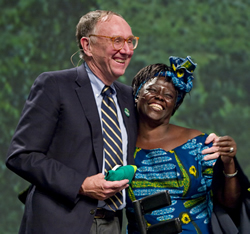Nobel Prize Winner Inspires the Audience at the Esri International User Conference
 Esri President Jack Dangermond welcomes Wangari Maathai, founder of the Green Belt Movement, to the 2007 Esri International User Conference's plenary session. She passionately explained her tree-planting mission to a rapt audience. |
Environmentalist Wangari Maathai received a rousing standing ovation at the 2007 Esri International User Conference, where she spoke passionately about the importance of planting trees to save the environment and protect people's lives and livelihoods.
Maathai, who won the 2004 Nobel Peace Prize for her work with the Green Belt Movement (GBM) in her native Kenya, was the keynote speaker at the June 18, 2007, Plenary Session at the San Diego Convention Center in San Diego, California.
She founded GBM, an organization that is responsible for having planted 35 million trees since 1977. Most of the plantings have been in Kenya and other African nations such as Tanzania, Uganda, and Malawi. GBM recently began to use geographic information system (GIS) technology to map and manage the tree plantings.
"I was inspired by women in the countryside in 1975," she said in an earlier interview about why she started the Green Belt Movement. She was about to embark on a trip to Mexico to attend a United Nations-sponsored meeting where issues relating to women were going to be addressed. Maathai said that women from the countryside came to her with the pressing concerns they wanted brought up at the conference. "Some of the issues they raised were they did not have enough water, they did not have firewood, they did not have adequate food, and they did not have adequate income," she said. "For me, it translated into poverty and environmental degradation."
Maathai said the root of the problem became clear to her: deforestation from agriculture, ranching, and even from people cutting too many trees for firewood. "We were losing the trees, and as a result, we were losing the soils," she added. "In a way, I recognized when people were poor, they were destroying their environment and vice versa." People were deforesting lands and losing their soil, so they couldn't grow crops. "They were," she said, "caught in a common vicious cycle." Crops in Kenya include maize and beans along with coffee and tea. The Green Belt Movement plants mainly fruit trees in the central African tropics but also indigenous trees at the higher altitudes in Kenya. The organization recently adopted GIS technology from Esri, which Maathai calls "an extremely valuable tool."
"GIS helps in marking and monitoring the trees, planning the plantings, and demonstrating whether the trees are surviving," Maathai continued. "Using satellite imagery in combination with the GIS helps show whether the environment is actually changing for the better. It makes our work easier to monitor and it's more efficient.
"It's extremely important to monitor the tree plantings for several reasons, one being accountability. People who plant trees must follow through to make sure they're thriving," she said, adding that this is a message she's constantly trying to communicate, especially to citizens of Africa and other developing nations that have lost many trees. "This is something you have to start and stay with it," Maathai added. "A tree starts from a seed and becomes a seedling. You have to water it and take care of it and protect it. It's a lot of work."
Maathai's keynote speech featured work that led to her winning the 2004 Nobel Peace Prize. Besides running an organization that plants trees, she advocates for human rights and supports peaceful, democratic change through the protection of the environment. She became the first African woman and the first environmentalist to receive the Nobel Peace Prize for her work in GBM and its impact on people and the planet.
Maathai spoke about the importance of providing civic and environmental education to people, using real-life examples from her own work in Kenya, where she has helped hundreds of thousands of women and their families improve their lives by planting trees. She also touched on educational campaigns done through GBM to raise awareness about women's rights, civic empowerment and the importance of voting, and children's education.
Part of the address highlighted the importance of GIS at GBM, where the technology is used to generate maps depicting valuable forested areas and the devastating effects of forest change over time. Satellite imagery, GPS-captured data, and 3D digital maps were used during the presentation to show where GBM tree planting was taking place to best replenish the country's precious vegetation. The presentation also touched on the United Nations Environment Programme (UNEP) worldwide tree planting campaign—Plant for the Planet Billion Tree Campaign. The campaign reaches out to people, communities, business and industry, civil society organizations, and governments to enter tree planting pledges online. The target goal of pledges to plant one billion trees worldwide has been surpassed.
Maathai concluded her talk by thanking "the GIS family for what you have done for us." She added that we can all do "the best we can for as long as we can."
Maathai won many supporters at the User Conference, with several saying she gave them an impetus for taking action. "I liked Wangari's talk," said Colleen Larsen, a GIS specialist for the Padre Dam Municipal Water District in Santee, California. "She's very inspiring, and I want to plant trees now."
To learn more about or donate to the Green Belt Movement, visit www.greenbeltmovement.org. To pledge to plant trees for the UNEP's Plant for the Planet: Billion Tree Campaign, visit www.unep.org/billiontreecampaign.